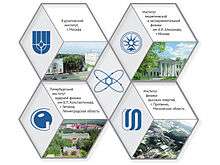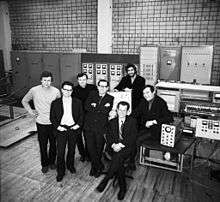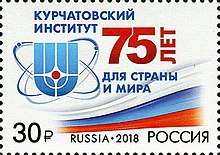Kurchatov Institute
The Kurchatov Institute (Russian: Hациональный исследовательский центр «Курчатовский Институт», 'National Research Centre "Kurchatov Institute"') is Russia's leading research and development institution in the field of nuclear energy. It is named after Igor Kurchatov and is located at 1 Kurchatov Square, Moscow.
 | |
| Established | February 11, 1943 |
|---|---|
Field of research | |
| Director | Alexander Blagov |
| Address | 1 Kurchatov Square |
| Location | Moscow, Moscow Oblast, Russia |
Collaborations | |
| Website | www |



In the Soviet Union it was known as I. V. Kurchatov Institute of Atomic Energy (Russian: Институт Атомной Энергии им. И.В. Курчатова), abbreviated KIAE (Russian: КИАЭ). Between 1991 and 2010, it was known as the Russian Scientific Centre "Kurchatov Institute" (Роcсийский научный центр «Курчатовский Институт») before its name was changed to National Research Centre.
History
Until 1955 known under a secret name "Laboratory No. 2 of the USSR Academy of Sciences", the Kurchatov Institute was founded in 1943 with the initial purpose of developing nuclear weapons. The majority of Soviet nuclear reactors were designed in the Institute, including the on-site F-1, which was the first nuclear reactor outside North America to sustain criticality.
Since 1955 it was also the host for major scientific experimental work in the fields of thermonuclear fusion and plasma physics. In particular, the first tokamak systems were developed there, the most successful of them being T-3 and its larger version T-4. T-4 was tested in 1968 in Novosibirsk, conducting the first quasistationary thermonuclear fusion reaction ever.[2]
In the 1980s Kurchatov Institute employees and computer engineers played a very important role in establishing computer culture through participating in the development of the DEMOS operating system. It lead to the spread of the internet in Russia and contributed to the dissolution of the Soviet Union.
Until 1991, the Ministry of Atomic Energy oversaw the Kurchatov Institute's administration. After the transformation into the State Scientific Center in November 1991, the Institute became subordinated directly to the Russian Government. According to the Institute's Charter, the Institute's director is appointed by the prime minister based on recommendations from Rosatom. In February 2005 Mikhail Kovalchuk was appointed director of the institute; since 2015 he is President of the Institute, and the position of a director was occupied by Drs. V. Ilgisonis, D. Minkin and (from Nov. 2018) Alexander Blagov.
In February 2007, the Kurchatov Institute won the tender to be the main organization coordinating efforts in nanotechnology in Russia.
Reactors
Many reactors were designed by researchers of the institute. such as:
References
- http://eng.nrcki.ru/
- Great Soviet Encyclopedia, 3rd edition, entry on "Токамак", available online here Archived 2016-06-03 at the Wayback Machine
External links
| Wikimedia Commons has media related to Kurchatov Institute. |